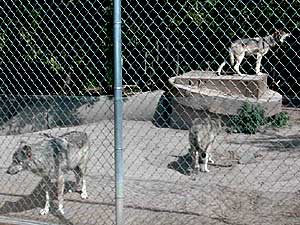|
Audio
Photos
Resources
Your Voice
|
Gray wolf on track for removal from endangered species list
July 16, 2004
 |
| The Wildlife Science Center's nearly 40 wolves help scientists understand the animals' reproductive behavior. (MPR photo/Dan Olson) |
Forest Lake, Minn. — A pen of red wolves at the Wildlife Science Center near Forest Lake was the backdrop for Interior Secretary Gale Norton's announcement. Norton says 30 years of federal protection have brought gray wolves back from the brink of extinction in Minnesota, Wisconsin and Michigan.
Scientists have relied on the center's wolf population to answer questions about how to re-introduce the species to the wild. Scientists estimate more than 2,000 gray wolves roam Minnesota, mostly in the north central and northeastern part of the state, compared to just a few hundred in the l950s.
 | |||
"(De-listing) for human terms is like taking a patient out of intensive care, and letting them out of the hospital," Norton says.
The wolf's demise in Minnesota and other states began in the 1800s. Bounties spurred hunting and trapping that caused the animal to disappear from its original range in Maine and to the west. The wolf was among the first animals protected, along with the bald eagle, when Congress approved the Endangered Species Act in l973.
At first, hunters and livestock owners were outraged. The wolf was blamed for depleting deer herds and killing livestock. But now, attitudes have changed.
The turnaround among many hunters is dramatic. Some estimates put wolf kills of deer in Minnesota at tens of thousands a year, depending on populations and weather. But Mark Johnson of Grand Rapids, the executive drector of the Minnesota Deer Hunters Association, says the state's deer population is large and wolves pose no threat to it.
 | |||
"Last year Minnesota hunters took over 300,000 deer, so we're definitely on the top of the predator list there. But the wolf is part of our environment, it's part of our ecosystem, and it's important to keep all those parts intact," Johnson says.
Many livestock owners have also had a change of heart. Their tolerance is based in part on being paid for their livestock losses if they can show wolves are responsible. However, Minnesota Cattlemen's Association spokesman Dale Lueck from Aitkin says their members agreed to forgo state compensation for wolf kills of livestock because of the state's tight budget.
"We can stand losing that reiumbursement. But don't dismantle the whole program, so that some point in the near future we would hope that it would be refunded," Lueck says.
Ending federal protection of the gray wolf would mean states take over management. Ginny Yingling, a spokeswoman for the North Star chapter of the Sierra Club, says wolf populations would decline as a result.
Even under federal protection as many as 200 nuisance wolves are killed each year in Minnesota. Yingling says the number would rise sharply if Minnesota's state plan takes effect, because it gives individuals more freedom to kill wolves on their property.
 | |||
"It's hard to say what that's going to do, and that's the concern. It's not so much are we going to decimate our population. I kind of doubt it," she says. "But what we do know is the population of wolves in Wisconsin and Michigan are in part supported by wolves out of Minnesota looking for territory. Should the combination of disease and killing here in Minnesota significantly reduce our population, it could have serious impact on the populations of wolves in those two states."
Biologists have used Minnesota as a center for the gray wolf recovery. The state's remnant population supplied breeding stock.
Minnesota's fascination with wolves helps support the independent, non-profit International Wolf Center in Ely. After Interior Secretary Norton and a string of officials thanked dozens of people for their help in the wolf recovery, the Wolf Center's director Walter Medwid thanked the wolves.
"It's resilient, it's adaptable, it's smart and it's tough," Medwid said.
A few seconds later, as if to spread word of Medwid's thanks, the nearly 40 wolves at the Wildlife Science Center responded with howls.
The proposal to de-list the gray wolf is open to public comment for several months. There are already two lawsuits challenging the plan. Federal officials say it will be at least a year before the gray wolf is removed from the endangered species list in Minnesota, Wisconsin, Michigan and 20 eastern states.
|
News Headlines
|
Related Subjects
|
